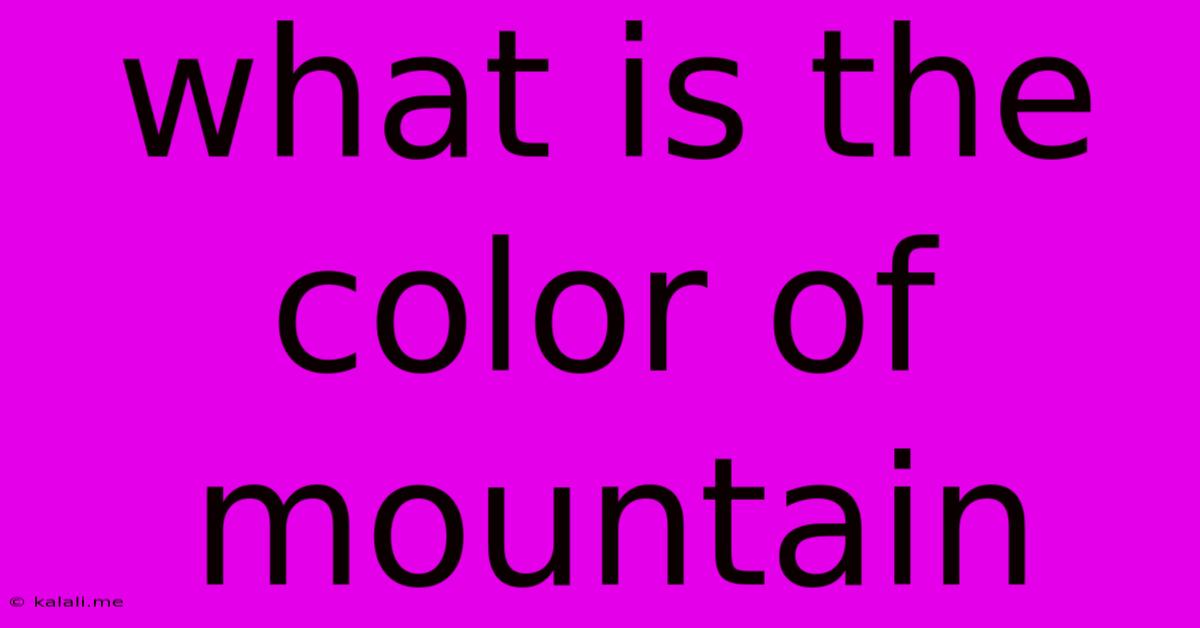What Is The Color Of Mountain
Kalali
May 23, 2025 · 3 min read

Table of Contents
What Color is a Mountain? It's More Than Meets the Eye!
The seemingly simple question, "What color is a mountain?" reveals a surprising complexity. While we might instantly picture a majestic, snow-capped peak gleaming white, or a rugged, earthy brown range, the reality is far more nuanced. The color of a mountain is a dynamic tapestry woven from geology, altitude, vegetation, time of day, and even the weather. This article delves into the diverse palette of mountain colors and the factors that contribute to their appearance.
The Underlying Geology: A Foundation of Color
The most fundamental determinant of a mountain's color is its geological composition. Different rock types possess distinct hues:
-
Grays and Browns: These are prevalent colors, often stemming from sedimentary rocks like sandstone and shale. These rocks are formed from compressed sediments, resulting in a range of earthy tones. The specific shade depends on the minerals present within the rock. Iron oxides, for example, contribute to reddish-brown hues.
-
Whites and Silvers: These are indicative of igneous rocks like granite, or the presence of snow and ice. Granite, formed from cooled magma, can exhibit light gray, almost white, appearances. Snow-capped peaks, of course, are iconic for their brilliant white.
-
Reds and Oranges: These vibrant colors often originate from iron oxides within the rock formations. These oxides are commonly found in sedimentary and metamorphic rocks, producing dramatic and visually striking mountains.
-
Blacks and Darks: Basalt, a dark-colored volcanic rock, creates mountains with deep, almost black hues. The presence of charcoal or other dark minerals can also contribute to darker shades.
-
Greens: While not directly from the rock itself, the presence of abundant vegetation can give a mountain a predominantly green appearance, especially at lower altitudes and in more temperate climates.
Altitude and Climate: Shaping the Visual Landscape
Altitude plays a significant role in a mountain's color. At higher elevations, we often see the stark whites and silvers of snow and ice, contrasting sharply with the darker hues at lower altitudes where vegetation is more prevalent. Climate also impacts the color: arid climates can lead to exposed rock faces with bolder, more intense colors, while wetter climates may see lush vegetation that softens the rock's underlying tone.
Time of Day and Weather: Shifting Perspectives
Even the time of day and weather conditions can subtly—or dramatically—alter the perceived color of a mountain. The angle of the sun affects shadows and highlights, making certain colors appear more vibrant at certain times. Cloudy weather can mute colors, while a clear, sunny day enhances them. Wet conditions can darken the appearance of rock faces, making them appear almost black in some cases.
Beyond the Basics: Unique Color Phenomena
Some mountains exhibit truly unique colorations due to specific geological processes or mineral deposits:
-
Rainbow Mountains: These breathtaking formations result from layers of sediment containing various minerals, creating stripes of vivid reds, oranges, yellows, and purples.
-
Colored Sand Dunes: In certain desert regions, mountains are partially composed of colored sand dunes, adding yet another layer of visual complexity to their overall appearance.
In conclusion, the color of a mountain is far from a simple answer. It's a complex interplay of geology, altitude, climate, time of day, weather, and sometimes, unique geological events. The next time you gaze upon a mountain, remember the rich story its color tells.
Latest Posts
Latest Posts
-
I M Trying To Get My Friends Out Of Facebook
May 23, 2025
-
Lyrics To I Am The Highway By Audioslave
May 23, 2025
-
How To Get A Bird Out Of Your House
May 23, 2025
-
What Does Background App Refresh Mean
May 23, 2025
-
Is Density An Intensive Or Extensive Property
May 23, 2025
Related Post
Thank you for visiting our website which covers about What Is The Color Of Mountain . We hope the information provided has been useful to you. Feel free to contact us if you have any questions or need further assistance. See you next time and don't miss to bookmark.